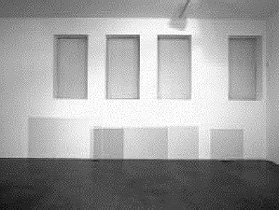
|
optimal conditions of visibility: |
|
|
FIG. 1 CAN | LATA |
|
One of the characters in Lewis Carroll's Sylvie and Bruno (1889) tells us of a nation that sought to improve upon the usefulness of its map by gradually expanding its scale, until, ultimately, it became a mile to a mile. The nation's farmers objected to the map's usage, however, since unfolding such a large map would block the sunlight. The map was thus never opened and, as a substitute, the country itself was used as its own map, supposedly functioning nearly as well. Notorious for creating tales full of absurd reason and mesmerizing warps in the fabric of space and time, Carroll is here playing with fundamental assumptions about representation: its role as surrogate, its status as an abstraction, and its use as a convention that references the real. Carroll's map, replaceable as it is by the territory it surveys, raises questions about what happens to representation when, at its limit, it resembles its subject so closely as to confound the distinction between what is real and what is not. In this case, the representation not only refuses to be subordinate to its subject but it is also interchangeable with it, and even superior, as we are slyly told. It has been over twenty years since Iran do Espírito Santo started distilling the essential nature of viewership and visual experience, and investigating the underpinnings of the constructed relationship between image and meaning. Carroll's tale is pertinent here not solely for its commentary on the codes and conundrums of representation, which happen to be central to the work of this artist. It is especially relevant for the analogous relationship it suggests with Espírito Santo's practice—specifically, the artist's infatuated, obsessed (and utterly impractical) quest for the perfected, ideal, and ultimately abstract condition of everyday things. Much of Espírito Santo's work has involved the somewhat quixotic task of redesigning industrial objects and patterns, in ways that aspire to total clarity of vision and wondrous perfection, transforming everyday design artefacts into icons of pure contemplation. Among his recent works are lusciously radiant stainless steel cylinders that, through the addition of a few accents, become objects that the viewer perceives as cans [fig. 1]. Conversely, one could say that these cans are so precisely defined and immaculately manufactured that they become temporarily dislocated from the familiar territory of the common object into the domain of ideas. This paradox is also informed by the particular process of their machined manufacture, chosen by the artist with the express intent of achieving a degree of objectivity and detail that may be beyond the grasp of human perceptual faculties. Despite no external visible indication of their weighty, homogenous solidity, each of these works is made from a block of stainless steel that is milled down to the shape of a can, rather than cast from a mould or stamped from a die. The cans therefore already originate from another cylinder, requiring only minimal intervention by the artist, as if demonstrating literally Cézanne's famous contention that all of nature can be distilled to the cylinder, sphere and cone. Attempting to capture the existence of a thing at its imminence, at the moment that it becomes something we name, Espírito Santo explores, simultaneously, its actual and idealized configurations; his cans appear at once as quotidian and timeless. Yet they are not a purely mental construct, maintaining a direct relationship to actual objects: i.e., each corresponds to a specific canned product that is commercially distributed, such as soybean oil, peeled tomatoes, coffee, asparagus, black olives, powdered milk, tuna, tomato paste, and peas. Observing a 1:2 ratio to their models, Espírito Santo's cans, perhaps against the odds, remain mnemonically connected to their shelf-life counterparts. Stripping away the layers of our assumptions about appearance, we come to the realization that the skin of these cans is, at the same time, their substance. The only thing that allows us to distinguish between inside and outside is the condition of image that is subtly iterated by the archetypal shape of the can itself, and which we may apprehend, visually and cognitively, as a kind of gestalt. In other words, what we are experiencing, or recognizing, is the "essence," or emblematic power, of a man-made thing that appears to be a can. It appears to us as a can, and then disappears into something else, precisely at that conjunction of surface and mass, so that the object becomes an image of something recognizable, and yet the perception of its mass transforms it into non-referential abstraction. Meaning is produced in this interval between these states of recognition and ambiguity. In these fourteen cans, as in much of Espírito Santo's earlier work, there is a continuous search for the impalpable objectivity of things. This creates a paradox, in which the greater the proximity to the specificity of an object, the more that same object's generic image is amplified into an archetypal condition, while remaining subtly linked to the material actuality of industrial design for a consumer society. Espírito Santo's worldview suggests a penchant for the pre-industrial, despite his fascination with modernity and mass production. With an attention to craft, paradoxically leading to the disappearance of all signs of the hand, Espírito Santo's aesthetic trajectory brings to mind the synthesis achieved by the Bauhaus in the mid 1920s: the reconciliation of Gothic-inspired craftsmanship and modern technology. Espírito Santo's work exists in the space between a condition of automated industrialized production and handcrafted, labour-intensive processes, while also conflating the formal vocabulary of mass production with the aura of the unique object. |

|

|
|
|
FIG. 2 USEFUL CONTENTS | CONTEÚDOS ÚTEIS |
FIG. 3 AMNESIA | AMNÉSIA |
|
Within the evolving circularity that characterizes Espírito Santo's post-conceptual practice, certain images and motifs recur, articulated through diverse manufacturing processes. For example, a series of five austere drawings in crayon and graphite, created in 1989 with the punning title Useful Contents, clearly anticipates the recent can sculptures in terms of the interplay of a suggested functionality and the poetics of depiction [fig.2]. To produce these drawings, Espírito Santo traced the individual silhouettes of several types of commercially available products, depicting them in black against a grey background, as if in a photographic negative. The drawings recover an abstract quality for each object, evoking the diagrammatic renderings of industrial design. Each object appears to be captured in its nascent state of existence, thus enunciating a kind of fantasy of each thing's primordial history. At what point does a mark become a figure? When does a figure become so familiar as to divest itself of its inherently material condition to become simply an idea? The passage from line to concept (and back) has preoccupied artists for centuries and still retains its fascination for us, perhaps given our tenuous perception of what constitutes the real. "In truth all things are basically lines that exist in space."1 Espírito Santo contends that ultimately much of his work references "the condition of working in the limit between abstract and concrete reality, a very important existential condition."2 His use of patterns traditionally associated with trompe l'oeil such as wood grain (faux bois) and brickwork—motifs that have persistently recurred in his work—address our keen disposition as viewers to make something of a line. |
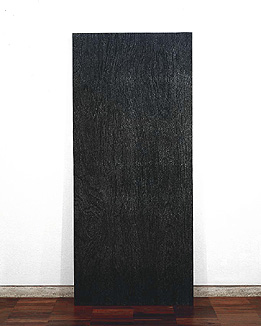
|
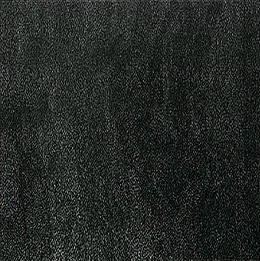
|
|
|
FIG. 4 DOOR | PORTA |
FIG. 5 PICTURES | QUADROS |
|
Espírito Santo's large-scale wall works of wood grain—the first examples dating back to 1990—are considerable undertakings, requiring outstanding skill and substantial physical labour [fig.3]. After applying a skin of black shoe polish (or, more recently, tempera) directly to the wall, the artist then meticulously, even manically, covers the entire surface with a series of marks that are both unique and the same, through an interplay of accident and control. Engaging in a futile attempt to replicate chance, Espírito Santo makes, literally from scratch, wood surfaces that exude a discreet yet stubborn condition. His motifs mutate and shift from architectural elements to a range of other mediums, a continuous interchange of visual and material associations—from a plank nonchalantly leaning against the wall to austere monochromatic paintings. Taken together, these distinct manifestations suggest an allegory of art practice [figs. 4 and 5]. The enigmatic, self-effacing presence that distinguishes the wood-grain wall works—and Espírito Santo's work as a whole—speaks to his inclination towards "things that the mind already knows,"3 and, for that matter, things that we often allow to fall quietly in the background of our perceptual range. Another of the artist's chosen motifs is brickwork, which has appeared in the form of painted wall works and as autonomous two and three dimensional pieces. These renditions are as impeccable as they are implausible, and evoke experiences of fragmentation and continuity that ultimately generate a kind of vertiginous planarity. The large-scale brick wall paintings created in 1997 for the San Francisco Museum of Modern Art employed a formal vocabulary reduced to three shades of grey, and involved the serial juxtaposition of rectangles whose dimensions corresponded to that of an actual brick [fig.6]. |
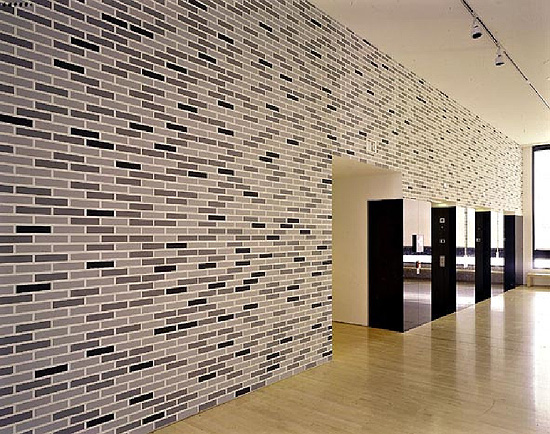
|
|
FIG. 6 EXTENSION | EXTENSÃO |

|
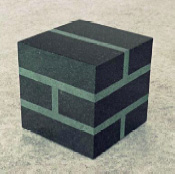
|

|
||
|
FIG. 7 UNTITLED | SEM TÍTULO |
FIG. 8 DIE | DADO |
FIG. 9 DEBRIS | DESTROÇOS |
|
As we begin to envision the bricks during our natural process of building an archetypal image, they become dissolved into a series of geometric shapes, and then convert into vertical and horizontal lines delimiting colour. What is evoked here is something like a wall that is replaced by a wall, thus confirming our expectations of what should occupy that place and creating, much like Carroll's map, a more perfect surrogate for the thing that it stands in for. It is noteworthy that the word "obra" in Portuguese signifies both "construction site" and "artwork," and that Espírito Santo's consolidation of both of these meanings in his wall works is probably not coincidental. Actual masonry, though significantly "corrected," had appeared in an earlier untitled work from 1994 in the form of a precariously standing wheel, like a wall on the move [fig.7]. This motif reemerges in 1997 as a granite piece entitled Die [fig.8], and more recently as variously configured stacked bricks in Debris, a series of approximately 16 sandstone sculptures [fig.9]. Beautifully carved out of one single block, they belie the perception of multiple concrete bricks, and speak to the impossible ambition of constructing a three-dimensional object that recedes in the background. |
|
|

|
|
FIG. 11 RESTLESS |
|
Deeply invested in complicating certain aspects of Duchamp's legacy, Espírito Santo's work obviously shares a keen affinity with ready-mades, especially if we understand them as the most extreme form of an object's representation. Like the signifying potential of the readymade, Espírito Santo's work also raises questions about where life ends and art begins. Notwithstanding close inspection, most of his works resemble ready-mades, although they are never found objects, albeit with one exception: a fully functioning wall light fixture made of brass with a light shade that the artist installed in an exhibition at Galeria Luisa Strina in São Paulo in 1995 [fig. 12]. Espírito Santo's fascination with this nondescript common object had to do with the aura of domestic comfort that it conferred upon the exhibition space. From that point on, the motif of light—actual or reflected, in all of its philosophical, religious, symbolic and physical dimensions—and of the literal light source (fluorescent and incandescent bulbs, candles, generic and designer lamps), would become a recurring theme. |
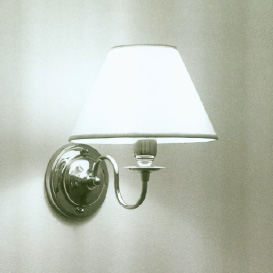
|

|
|
|
FIG. 12 UNTITLED | SEM TÍTULO |
FIG. 13 ABAT-JOUR |
|
Abat-Jour (1996) is a sculpture made of solid stainless steel that replicates a plastic table lamp designed by Philippe Starck, with a highly reflective finish and streamlined shape [fig. 13]. As in Brancusi's luminous sculpture, light is emitted through reflection. Perhaps a more direct art historical reference can be identified in Fluorescent I (2000), a 60 cm long fluorescent bulb and fixture fabricated in stainless steel, and installed vertically at eye level [fig. 14]. Dan Flavin removed the fluorescent bulb from its primary intended use by dislocating it into the condition of an artwork, and here Espírito Santo confers this common object with an ontological weight, and an absolute sense of presentness, by bringing it into the traditional sculptural realm. More recently, the regular incandescent light bulb became the subject of a recent series of works that seem to generate an alternative set of iconic artefacts of industrial culture [fig. 15]. Despite their tactile materiality and resolute gravitas, in conjunction with the heightened sense of beauty and perfection that is conferred upon the viewer, we are invited to see these artefacts as signs, much like an idea bubble in a cartoon. |

|

|
|
|
FIG. 14 FLUORESCENT 1 | FLUORESCENTE |
FIG. 15 BULB 1 | LÂMPADA |
|
In conclusion, it might be useful to reflect upon the conceptual linkages of the still life genre to Espírito Santo's recurrent themes, as well as to his discreet yet ambitious sensibility. Historically considered to be the lowest category of picture-making, still life tended to examine the overlooked marks of domesticity within our immediate surroundings. Such paintings conventionally focused on the ordinary to the detriment of the exceptional and the grandiose. Contrary to other well established genres like portraiture and history painting, still life's attention centered on situations, as Norman Bryson writes, that were "not the large-scale, momentous events of History, but the small-scale, trivial, forgettable acts of bodily survival and selfmaintenance."4 Espírito Santo similarly approaches his subjects with a heightened, hyperreal visuality that seeks to dislodge our habitual apathy towards the mundane, instead privileging a unique personal experience in contradistinction to the common collective event. Significantly, his work proposes interpenetration between our basic life condition and the possibility of nuanced and sophisticated excess. Perhaps, this lavish treatment of the commonplace is really a means of imagining an alternative hierarchy based not upon what is externally valued, but upon what is privately owned—the possibility of bringing to the foreground a world seemingly without importance, moving away from the theatre of greatness to find our own marvellous things. Notes: 1. Iran do Espírito Santo in conversation with Lilian Tone, São Paulo, March 2005. 2. Iran do Espírito Santo in conversation with Lilian Tone, São Paulo, March 2005. 3. Jasper Johns's famous quote first appeared in "His Heart Belongs to Dada," Time 73 (May 4, 1959), p.58. 4. Norman Bryson, Looking at the Overlooked: Four Essays on Still Life Painting. London: Reaktion Books, 1990, p. 14. |
